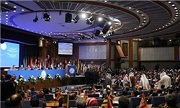
Hosting the Tehran summit of the Non-Aligned Movement (NAM) and its 120 member states is a public relations coup for Iran. Isolated by the major world powers and weakened by sanctions, Iran is in desperate need of solidarity, which the NAM conference hands to Iran on a silver platter. It is the first time in years that Tehran plays host to such a number of high-level delegations.
Despite their attempts—including a letter from Prime Minister Benyamin Netanyahu— the United States and Israel have been unable to stop the UN Secretary-General, Ban Ki-moon, from attending. Indian Prime Minister Manmohan Singh is participating, and the appearance of Egyptian president Mohammed Morsi—the first of its kind in more than thirty years of severed diplomatic relations—is also of great significance.
The participation of other regional leaders, such as Iraqi Prime Minister Nouri al-Maliki representing the Arab world, Pakistani President Asif Ali Zardari, and Afghan President Hamid Karzai, also play an important symbolic role for the summit.
More sobering is the presence of a relatively low-level delegation from Saudi Arabia, represented by Prince Abdulaziz bin Abdullah, acting Deputy Foreign Minister, which dampens somewhat the overly optimistic forecasts of a rapprochement between Iran and Saudi Arabia that were made after King Abdullah’s unusually warm reception of his Iranian guest, President Ahmadinejad, at the Organizations of Islamic Cooperation (OIC) summit earlier this month. Also, despite earlier announcements to the contrary, the Kuwaiti and Qatari Emirs, as well as the Lebanese president are not participating in the summit, but are instead represented by their foreign ministers.
Nonetheless, the meeting gives Iran a unique opportunity to air its arguments and showcase its cause—see for example the photograph of damaged cars in which Iranian scientists that were supposedly involved in Iran’s nuclear program were attacked, which has been reprinted in papers across the world, from the New York Times to The Hindu.
The extent of its success as a public relations campaign, however, will largely depend on whether the Iranians use it as a platform to let loose provocative statements that alienate participants and international observers, or to make constructive recommendations that may achieve some sort of traction with follow-up meetings.
In the post-Cold War period the NAM has been influential by taming its wilder instincts and entering into pragmatic partnerships with powerful countries outside the organization, or on the back of some of the very powerful individual countries within. The forward-looking 2003 summit in Kuala Lumpur, under Malaysian leadership, for example, contrasts with the acrid statements which came out of the Harare summit in 1986.
Few, however, expect a concrete political outcome of major consequence this year. Secretary-General Ban Ki-moon will most probably not come back to New York with a breakthrough on the negotiations over the Iranian nuclear program. Nor does it seem that the summit participants will try to mobilize the NAM group at the General Assembly to pass a resolution–a rare occurrence even in the best of circumstances. However, the Tehran summit is less about content than about public relations, and not just in terms of the image of Iran that is being projected.
The importance of the summit is also in the meetings that take place on its margins. In this regard the visit by the president of Egypt to the Iranian capital is of particular interest. He is coming to Tehran after a visit to China and as part of a diplomatic tour, which features the Syrian crisis and a new regional scheme to solve it at the top of the agenda. The new initiative was first made public earlier this month at an emergency meeting of the OIC in Mecca, where President Morsi called for the creation of a quartet composed of Saudi Arabia, Iran, Egypt, and Turkey to unravel the bloody conflict in Syria. The Iranians appear, however, to be calling for support for an initiative of their own, consisting of a ceasefire followed by national reconciliation talks. Thus the critical situation in Syria is predictably looming large over the summit. The capacity for the NAM, one of the largest groupings in the UN, to come to any sort of agreement is, however, limited.
Jose Vericat is an Adviser at the International Peace Institute.
About the Photo: NAM foreign ministers meet in Tehran. Photo from mfa.gov.ir.




